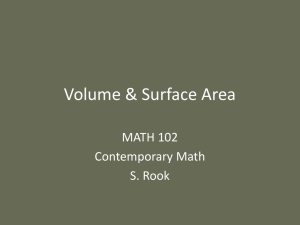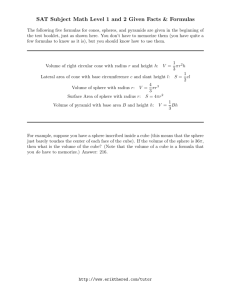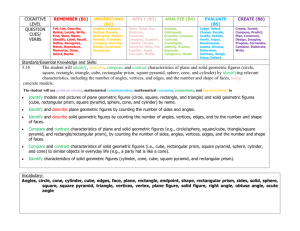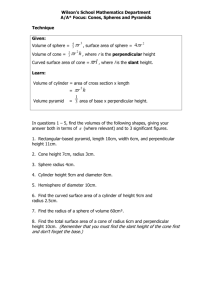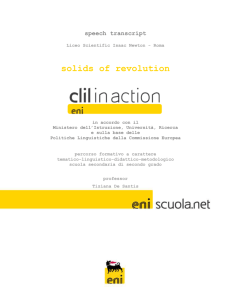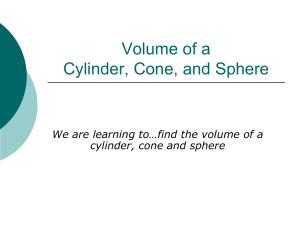Document
advertisement
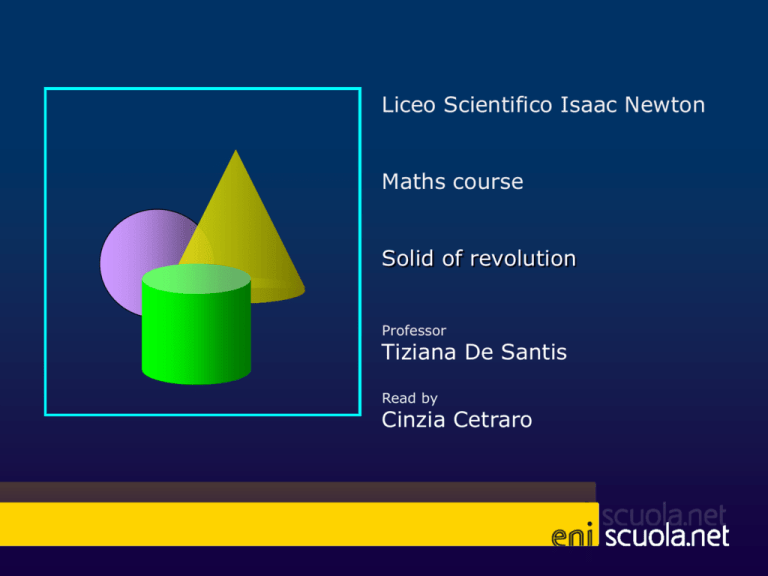
Liceo Scientifico Isaac Newton Maths course Solid of revolution Professor Tiziana De Santis Read by Cinzia Cetraro A solid of revolution is obtained from the rotation of a plane figure around a straight line r, the axis of rotation; if the rotation angle is 360° we have a complete rotation All points P of the plane figure describe a circle belonging to the plane that is perpendicular to the axis and passing through the point P axis P P r Cylinder The infinite cylinder is the part of space obtained from the complete rotation of a straight line s around a parallel straight line r The part of an infinite cylinder delimited by two parallel planes is called a cylinder, if these planes are perpendicular to the rotation axis, then it is called a right cylinder s s rr s – generatrix r – axis The cylinder is also obtained from the rotation of a rectangle around one of its sides It is called height The sides perpendicular to the height are called radii of base The bases of the cylinder are obtained from the complete rotation of the radii of the base base height radius base Cone If we consider a anhalf-line s having V The half-line s line describes infinite conical surface and and a straight r passing through V called axis the point infinite cone is the partof ofthe space obtained from the V is called vertex cone as the initial point complete rotation of the angle α around r s V V α α r s r infinite cone infinite conical surface If the infinite cone is intersected by The right circular cone is also obtained from the rotation of a right triangle around one of its catheti a plane perpendicular to the axis of A cone is called equilateral if its apothem is congruent to the diameter of the base rotation, the portion of the solid V bounded between the plane and the VP - apothem vertex is called right circular cone VH - height base H P HP - radius of base If we section a cone with a plane that is parallel to the base, we obtain two solids: a small cone that is similar to the previous one and a truncated cone V H’ H’ small cone α’ truncated cone H H α Theorem: the measure of the areas C and C’, obtained from a parallel section, are in proportion with the square of their respective heigths V Hp: α // α’ C’ H’ H’ α’ VH ┴ α Th: C : C’ = VH2 : VH’ 2 H C H α Sphere A spheric surface is the boundary formed by the complete rotation of a is half-circumference around its diameter The sphere completely symmetrical around its centre called symmetry The rotation of a centre half-circle generate a solid, the sphere Every plane passing through the centre of a sphere is a The centreplane of the half-circle is the center of the sphere, symmetry while its radius ispassing the distance between all are points on the The straight-lines through its centre symmetry surface and the centre axes PC - radius P C C - center Positions of a straight line in relation to a spheric surface C C C B A A Secant: d < r Tangent: d = r External: d > r d - distance from centre C to straight line s r - radius of the sphere Position of a plane in relation to a spheric surface SECANT PLANE: TANGENT PLANE: EXTERNAL PLANE: intersection is a circle intersection is a point no intersection Torus The torus is a surface generated by the complete rotation of a circle around an external axis s coplanar with the circle s s Surface area and volume calculus Habakkuk Guldin (1577 –1643) Surface area calculus Pappus-Guldin’s Centroid Theorem The measure of the area of the surface generated by the rotation of an arc of a curve around an axis, is equal to the product between the length l of the arc and the measure of the circumference described by its geometric centroid (2 π d ) S=2πdl Cone Geometric centroid l=√h2+r2 d =r/2 r/2 l h SL=π r √ h2+ r2 r Cylinder r h l=h d=r SL=2 π r h SL - lateral surface Torus R r l=2πr O S=4 d=R π2rR Sphere Geometric centroid l = πr S=4 d = 2r/π π r2 Volume solids Pappus-Guldin’s second theorem states that the volume of a solid of revolution generated by rotating a plane figure F around an external axis is equal to the product of the area A of F and the length of the circumference of radius d equal to the distance between the axis and the geometric centroid (2 π d) V=2 πdA Cylinder geometric centroid A=hr d=r/2 d h V= π r2h r geometric centroid Cone A=(hr)/2 h d r V= (π r2h)/3 d=r/3 Geometric centroid R Torus A=πr2 r d=R V= 2π2r2R Sphere Geometric centroid A=πr2/2 r V= 4πr3/3 d=4r/3π “On the Sphere and Cylinder” Archimedes (225 B.C.) The surface area of the sphere is equivalent to the surface area of the cylinder that circumscribes it r 2r r Scylinder=2πr∙2r=4 πr2 Ssphere=4 πr2 Archimedes The volume of the sphere is equivalent to 2/3 of the cylinder’s volume that circumscribes it r 2r r Scylinder=πr2∙2r=2 πr3 Ssphere=4 πr2/3 Archimedes The volume of the cylinder having radius r and height 2r is the sum of the volume of the sphere having radius r and that of the cone having base radius r and height 2r r r 2r 2πr3 2r r = (4πr3)/3 + (πr3)/3 Galileo’s bowl h r Circle Annulus (section bowl) h (section cone) Vcone =r Vbowl r Vcylinder = Vbowl + Vhalf_sphere Vhalf_sphere = Vcylinder - Vcone Theorem: The sphere volume is equivalent to that of the anti-clepsydra Vanti-clepsydra = Vsphere o o Vanti-clepsydra = Vcylinder- 2 Vcone Vsphere = 2πr3 – (2πr3)/3= (4πr3)/3 Special thanks to prof. Cinzia Cetraro for linguistic supervision Some of the pictures are taken from Wikipedia

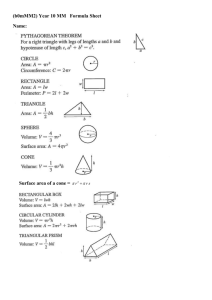
![Volume of Pyramids, Cones, and Spheres [12/4/2013]](http://s2.studylib.net/store/data/005724855_1-4c0eaf218975fc4d9fe792c18193e4dc-300x300.png)
